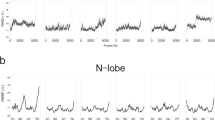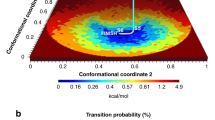Abstract
We have determined the solution structures of the apo and (Ca2+)2 forms of the carboxy-terminal domain of calmodulin using multidimensional heteronuclear nuclear magnetic resonance spectroscopy. The results show that both forms adopt well-defined structures with essentially equal secondary structure. A comparison of the structures of the two forms shows that Ca2+ binding causes major rearrangements of the secondary structure elements with changes in inter-residue distances of up to 15 Å and exposure of the hydrophobic interior of the four-helix bundle. Comparisons with previously determined high-resolution X-ray structures and models of calmodulin indicate that this domain is structurally autonomous.
This is a preview of subscription content, access via your institution
Access options
Subscribe to this journal
Receive 12 print issues and online access
$189.00 per year
only $15.75 per issue
Buy this article
- Purchase on Springer Link
- Instant access to full article PDF
Prices may be subject to local taxes which are calculated during checkout
Similar content being viewed by others
References
Klee, C.B. in Molecular Aspects of Cellular Regulation (eds. Cohen, P. & Klee, C.B.) 35–56 (Elsevier, New York; 1988).
Crivici, A. & Ikura, M. Molecular and structural basis of target recognition by calmodulin. Annu. Rev. biophys. biomol. Struct. 24 85–116 (1995).
Kawasaki, H. & Kretsinger, R.H., Calcium-Binding Proteins 1: EF-hands. Protein Profile 1 343–346 (1994).
Walsh, M., Stevens, F.C., Kuznicki, J. & Drabikowski, W. Characterization of tryptic fragments obtained from bovine brain protein modulator of cyclic nucleotide phosphodiesterase. J. biol. Chem. 252 7440–7443 (1977).
Drabikowski, W., Kuznicki, J. & Grabarek, Z. Similarity in Ca2+-induced changes between troponin-C and protein activator of 3′:5′-cyclic nucleotide phosphodiesterase and their tryptic fragments Biochim. biophys. Acta 485 124–133 (1977).
Babu, Y.S., Bugg, C.E. & Cook, W.J. Three-dimensional structure of calmodulin refined at 2. 2 Å resolution. J. molec. Biol. 204, 191–204 (1988).
Chattopadhyaya, R., Meador, W.E., Means, A.R. & Quiocho, F.A. Calmodulin structure refined at 1.7 A resolution J. molec. Biol. 228, 1177–92 (1992).
Taylor, D.A., Sack, J.S., Maune, J.F., Beckingham, K. & Quiocho, F.A. Structure of a recombinant calmodulin from Drosophila melanogaster refined at 2.2- Å resolution J. biol. Chem. 266, 21375–80 (1991).
Rao, S.T. et al. Structure of Paramecium tetraurelia calmodulin at 1.8 Å resolution Protein Sci. 2, 436–47 (1993).
Barbato, G., Ikura, M., Kay, L.E., Pastor, R.W. & Bax, A. Backbone dynamics of calmodulin studied by 15N relaxation using inverse detected two-dimensional NMR spectroscopy: the central helix is flexible Biochemistry 31, 5269–78 (1992).
Heidorn, D.B. & Trewhella, J. Comparison of the crystal and solution structures of calmodulin and troponin C. Biochemistry 27, 909–915 (1988).
Meador, W.E., Means, A.R. & Quiocho, F.A. Target enzyme recognition by calmodulin: 2.4 Å structure of a calmodulin-peptide complex Science 257, 1251–5 (1992).
Meador, W.E., Means, A.R. & Quiocho, F.A. Modulation of calmodulin plasticity in molecular recognition on the basis of X-ray structures. Science 262, 1718–1721 (1993).
Ikura, M. et al. Solution structure of a calmodulin-target peptide complex by multidimensional NMR Science 256, 632–8 (1992).
Clore, G.M., Bax, A., Ikura, I. & Gronenborn, A.M. Structure of calmodulin-target peptide complexes Curr. Opin. struct. Biol. 3, 838–845 (1993).
Finn, B.E. & Forsén, S. The evolving model of calmodulin structure, function and activation. Structure 3, 7–11 (1995).
Herzberg, O. & James, M.N.G. Structure of the calcium regulatory muscle protein troponin C at 2.8 Å resolution Nature 313, 653–659 (1985).
Herzberg, O. & James, M.N.G. Refined crystal structure of troponin C from turkey skeletal muscle at 2.0 Å. J. molec. Biol. 203, 761–779 (1988).
LaPorte, D.C., Wierman, B.M. & Storm, D.R. Calcium-induced exposure of a hydrophobic surface on calmodulin. Biochemistry 19, 3814–3819 (1980).
Seaton, B.A., Head, J.F. & Richards, F.M. Calcium-induced increase in the radius of gyration and maximum dimension of calmodulin measured by small-angle X-ray scattering Biochemistry 24, 6740–6743 (1985).
Strynadka, N.C.J. & James, M.N.G. Two trifluoroperazine-binding sites on calmodulin predicted from comparative molecular modeling with troponin C. Proteins Struct. Func. Genet. 3, 1–17 (1988).
Finn, B.E., Drakenberg, T. & Forsén, S. The structure of apocalmodulin: A1H NMR examination of the carboxy-terminal domain. FEBS Lett. 336, 368–374 (1993).
Laskowski, R.A., MacArthur, M.W., Moss, D.S. & Thornton, J.M. PROCHECK: a program to check the stereochemical quality of protein structures J appl. Crystallogr. 26, 283–291 (1993).
Kabsch, W. & Sander, C. Dictionary of protein secondary structure: Pattern recognition of hydrogen-bonded and geometrical features. Biopolymers 22, 2577–2637 (1983).
Pedigo, S. & Shea, M.A. Quantitative endoprotease GluC footprinting of cooperative Ca2+ binding to calmodulin: Susceptibility of E31 and E87 indicates interdomain interactions. Biochemistry 34, 1179–1196 (1995).
Hennessey, J.P.J., et al. Conformational transitions of calmodulin as studied by vacuum-UV CD Biopolymers 26, 561–571 (1987).
Linse, S., Helmersson, A. & Forsén, S. Calcium binding to calmodulin and its globular domains J. biol. Chem. 266, 8050–4 (1991).
Manning, M.C. Underlying assumptions in the estimation of secondary structure in proteins by circular dichroism spectroscopy - A critical review. J. Pharm. biomed. Analysis 7, 1103–1119 (1989).
Gagné, S.M., et al. Quantification of the calcium-induced secondary structural changes in the regulatory domain of troponin-C Prot. Sci. 3, 1961–1974 (1994).
Urbauer, J.L., Short, J.H., Dow, L.K. & Wand, J.A. Structural analysis of a novel interaction by calmodulin: High-affinity binding of a peptide in the absence of calcium. Biochemsitry 34, 8099–8109 (1995).
Brodin, P., et al. Expression of bovine intestinal calcium binding protein from a synthetic gene in Escherichia coli and characterization of the product. Biochemistry 25, 5371–5377 (1986).
Macura, S. & Ernst, R.R. Elucidation of cross relaxation in liquids by two-dimensional N.M.R. spectroscopy Mol. Phys. 41, 95–117 (1980).
Bax, A. A spatially selective composite 90 degree radiofrequency pulse. J. magn. Reson. 65, 142–145 (1985).
Aue, W.P., Batholdi, E. & Ernst, R.R. Two-dimensional spectroscopy: Application to nuclear magnetic resonance. J. chem. Phys. 64, 2229–2246 (1976).
Mueller, L.P.E. COSY, a simple alternative to E-COSY J. magn. Reson. 72, 191–196 (1987).
Braunschweiler, L. & Ernst, R.R. Coherence transfer by isotropic mixing: Application to proton correlation spectroscopy. J. magn. Reson. 53, 521–528 (1983).
Bax, A. & Davis, D.G. MLEV-17 based two-dimensional homonuclear magnetization transfer spectroscopy. J. magn. Reson. 65, 355–360 (1985).
Marion, D., Kay, L.E., Sparks, S.W., Torchia, D.A. & A., B. Three-dimensional heteronuclear NMR of 15N-labeled proteins. J. Am. chem. Soc. 111, 1515 (1989).
Koning, T.M.G., Boelens, R. & Kaptein, R. Calculation of the nuclear Overhauser effect and the determination of proton-proton distances in the presence of internal motions J. magn. Reson. 90, 111–123 (1990).
Tropp, J. Dipolar relaxation and nuclear Overhauser effects in nonrigid molecules: The effect of fluctuating internuclear distances J. chem. Phys. 72, 6035–6043 (1980).
Montelione, G.T., Winkler, M.E., Rauenbuehler, P. & Wagner, G. Accurate measurements of long-range heteronuclear coupling constants from homonuclear 2D NMR spectra of isotope-enriched proteins J. magn. Reson. 82, 198–204 (1989).
Brünger, A.T. X-PLOR Version 3.7 (Yale University, New Haven; 1992).
Nilges, M., Clore, G.M. & Gronenborn, A.M. Determination of three-dimensional structures of proteins from interproton distance data by hybrid distance-dynamical simulated annealing calculations FEBS Lett. 229, 317–324 (1988).
Nilges, M.A. A calculational strategy for the structure determination of symmetric dimers by 1H NMR. Proteins Struct. Funct. Genet. 17, 295–309 (1993).
Ferrin, T.E., Huang, C.C., Jarvis, L.E. & Langridge, R. The MIDAS display system J. molec. Graphics 6, 13–27 (1988).
Author information
Authors and Affiliations
Rights and permissions
About this article
Cite this article
Finn, B., Evenäs, J., Drakenberg, T. et al. Calcium-induced structural changes and domain autonomy in calmodulin. Nat Struct Mol Biol 2, 777–783 (1995). https://doi.org/10.1038/nsb0995-777
Received:
Accepted:
Issue Date:
DOI: https://doi.org/10.1038/nsb0995-777
This article is cited by
-
Structural dynamics of calmodulin-ryanodine receptor interactions: electron paramagnetic resonance using stereospecific spin labels
Scientific Reports (2018)
-
Conformational heterogeneity of the calmodulin binding interface
Nature Communications (2016)
-
Structure of myosin-1c tail bound to calmodulin provides insights into calcium-mediated conformational coupling
Nature Structural & Molecular Biology (2015)
-
Effect of the Brugada syndrome mutation A39V on calmodulin regulation of Cav1.2 channels
Molecular Brain (2014)
-
Electron Paramagnetic Resonance Spectroscopy of Nitroxide-Labeled Calmodulin
The Protein Journal (2014)



